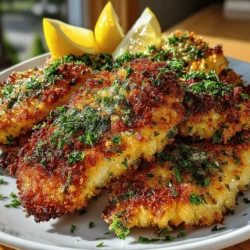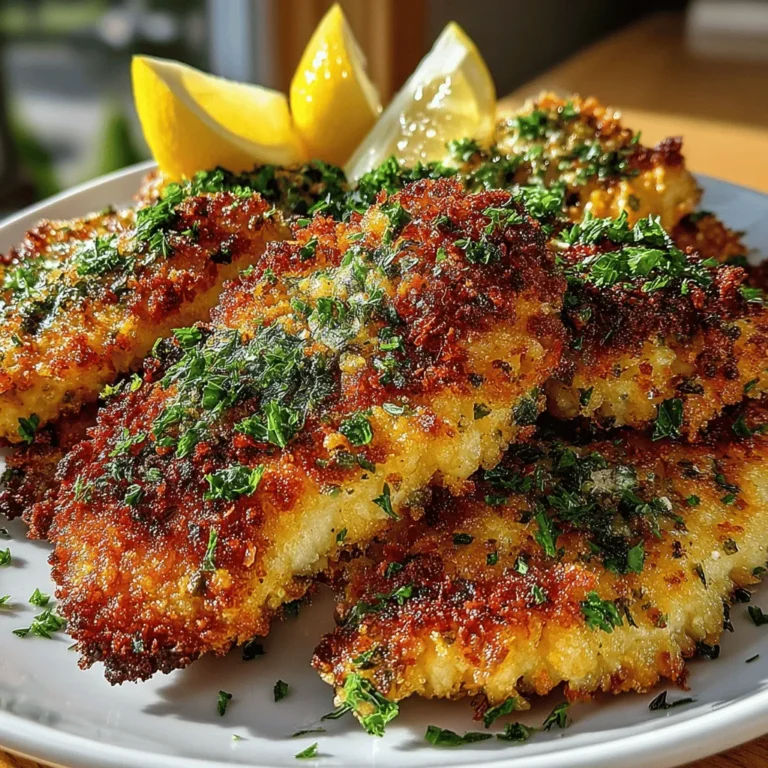Crunchy Zesty Oven-Baked Chicken Tenders: A Flavorful Delight for Every Occasion
Chicken tenders are a beloved staple in households around the world, celebrated for their tender texture and appealing flavor. From family dinners to casual gatherings with friends, these bite-sized morsels have a universal appeal that transcends age and culinary preference. Whether you’re serving them up as a main course, a snack, or an appetizer, chicken tenders are sure to please a crowd.
The Allure of Chicken Tenders
The popularity of chicken tenders is evident in their presence on menus at restaurants, fast-food joints, and home kitchens alike. Kids adore them, making them an easy choice for parents looking to satisfy picky eaters. Adults appreciate them too, often relishing the nostalgia associated with this comfort food. Their versatility is unmatched; chicken tenders can be enjoyed in various ways, such as with dipping sauces, on top of salads, or even in wraps.
One of the most appealing aspects of chicken tenders is their adaptability. You can effortlessly modify the flavor profile to suit any occasion. Want something spicy? Add cayenne pepper to the coating. Prefer a hint of sweetness? A drizzle of honey in the marinade can do the trick. The options are endless, making chicken tenders a fantastic canvas for culinary creativity.
Understanding the Ingredients
To create the perfect Crunchy Zesty Oven-Baked Chicken Tenders, understanding the ingredients is crucial. Each component plays an essential role in achieving the dish’s signature taste and texture.
Chicken Breast Tenders
The star of this recipe is the chicken breast tenders. These are lean cuts of meat that provide a substantial amount of protein without excess fat, making them a healthier option compared to dark meat. Their natural tenderness ensures that they cook quickly and remain juicy, especially when prepared properly. Using chicken breast tenders not only contributes to a healthier meal but also allows for a satisfying bite that is both filling and flavorful.
Buttermilk
Buttermilk is a key ingredient in this recipe, serving two vital functions. First, it acts as a tenderizer for the chicken, breaking down proteins and making the meat even more succulent. Second, the tangy flavor of buttermilk enhances the overall taste profile of the tenders. The acidity in buttermilk pairs beautifully with spices, allowing for a more robust flavor experience.
Spices and Seasonings
The combination of spices in this recipe is what truly brings the chicken tenders to life. Garlic powder offers a savory depth, while onion powder adds a subtle sweetness. Smoked paprika introduces a hint of smokiness that elevates the flavor, providing a delicious contrast to the other seasonings. The blend of these spices creates a zesty profile that makes each bite of chicken tender burst with flavor.
Panko Breadcrumbs
For that irresistible crunch, panko breadcrumbs are essential. Unlike traditional breadcrumbs, panko is coarser and lighter, resulting in a crispier texture when baked. This unique composition allows for a delightful crunch that pairs perfectly with the tender chicken, making each bite a satisfying experience. Panko breadcrumbs also absorb less oil, contributing to a healthier final product while still achieving that sought-after crunch.
Olive Oil Spray
To achieve the perfect golden-brown finish, a light spray of olive oil is used. Not only does olive oil add richness and depth of flavor, but it also enhances the crispiness of the breading. Additionally, olive oil is a heart-healthy fat, making it a better choice for those looking to maintain a balanced diet.
Marination: The Key to Flavorful Chicken
Marinating the chicken tenders in buttermilk and hot sauce is a crucial step in this recipe. This process is not simply for flavor; it’s rooted in science. The acid in buttermilk and hot sauce helps to break down the proteins in the chicken, resulting in a more tender and juicy final product. Moreover, marination allows the spices to penetrate the meat, infusing it with flavor from the inside out.
For optimal flavor infusion, it is recommended to marinate the chicken tenders for at least 30 minutes, although a longer marination time—up to overnight—can yield even more pronounced flavors. If you’re in a hurry, even a brief soak will still improve the tenderness and flavor, but planning ahead can take the dish to the next level.
Creating the Perfect Breading Station
Once your chicken tenders have marinated and are ready to be transformed into crunchy delights, setting up a proper breading station is essential for success. This will streamline the process and ensure that each tender is evenly coated.
Begin by preparing three shallow dishes: one for the seasoned flour, another for the buttermilk mixture, and the last for the panko breadcrumbs. In the first dish, combine all-purpose flour with your favorite spices, ensuring an even distribution. This seasoned flour will help the buttermilk adhere better to the chicken.
In the second dish, pour in the buttermilk, allowing the tenders to soak up that creamy goodness before they make their way to the breadcrumbs. The final dish should be filled with panko breadcrumbs, mixed with a sprinkle of salt and pepper to enhance the flavor.
With your breading station set up, it’s time to coat the chicken tenders. Start by dredging each tender in the seasoned flour, shaking off any excess. Next, dip it into the buttermilk, ensuring it is well-coated before transferring it to the panko breadcrumbs. Press down gently to ensure the breadcrumbs adhere well, and repeat this process until all tenders are coated.
These initial steps lay the groundwork for creating the Crunchy Zesty Oven-Baked Chicken Tenders that will not only satisfy your taste buds but also impress your guests. The combination of careful preparation, quality ingredients, and attention to detail will ensure that your chicken tenders are the star of any meal.
{{image_2}}
Preparation of the Breading Station
Creating a successful breading station is crucial for achieving the perfect coating on your chicken tenders. The process is simple but requires some attention to detail to ensure an even and crispy texture. Start by setting up three shallow bowls or plates:
1. Flour Mixture: In the first bowl, combine all-purpose flour with a mix of seasonings. Common additions include garlic powder, onion powder, paprika, salt, and pepper. This mixture provides a base layer of flavor and helps the egg adhere to the chicken.
2. Egg Wash: In the second bowl, whisk together eggs and a splash of water or milk until well blended. The egg wash acts as a bonding agent, allowing the breadcrumbs to stick effectively to the chicken.
3. Panko Breadcrumbs: The third bowl should contain panko breadcrumbs mixed with additional seasonings or grated Parmesan cheese for an extra flavor boost. Panko is lighter than traditional breadcrumbs and creates a crunchier texture when baked.
The Role of Each Component in the Breading Process
Understanding the purpose of each component in your breading station can help you master the art of coating chicken tenders:
– Flour Mixture: The flour not only adds flavor but also creates a dry surface on the chicken, allowing the egg wash to adhere more effectively. This initial layer is crucial for ensuring that the breading sticks throughout the baking process.
– Egg Wash: This moist layer captures the panko breadcrumbs, creating a cohesive coating that will crisp up beautifully in the oven. The egg also contributes to a richer flavor and golden color.
– Panko Breadcrumbs: Panko is key to achieving that desired crunch. Its larger, coarser texture compared to regular breadcrumbs allows for more air pockets, leading to a more appealing crispness when baked.
Achieving the Ideal Texture and Crunch
For the ultimate crunchy texture, ensure each chicken tender is coated thoroughly at every step. Here’s how to do it:
1. Dredging: Start by dredging each chicken tender in the flour mixture, shaking off any excess.
2. Egg Wash: Next, dip the floured tender into the egg wash, fully coating it.
3. Panko Coating: Finally, press the tender into the panko breadcrumbs, ensuring it’s fully coated. For extra crunch, you can double-dip the tenders by repeating the egg wash and panko steps.
Baking Technique for Optimal Crispiness
Preheating the Oven and Preparing the Baking Sheet
Preheating your oven is essential for achieving the perfect bake. Set your oven to 425°F (220°C) and allow it to preheat fully. This high temperature will help the coatings crisp up quickly, resulting in a delightful crunch. While the oven heats up, line a baking sheet with parchment paper or aluminum foil, which can help with clean-up afterward.
Arranging the Tenders in a Single Layer
When placing the tenders on the baking sheet, arrange them in a single layer with space between each piece. This is vital as it allows hot air to circulate around the chicken, promoting even cooking and preventing steaming. Overcrowding the pan will lead to soggy tenders, so ensure each piece has its own space.
The Role of Olive Oil Spray
To enhance the crispiness of your chicken tenders, lightly spray the coated tenders with olive oil before baking. This step is crucial as it helps the breadcrumbs to brown and become crispy. The oil provides a barrier to moisture, ensuring that the tenders remain juicy on the inside while the exterior gets perfectly crunchy.
Cooking Time and Temperature
Baking Process
Once your tenders are ready and arranged on the baking sheet, it’s time to bake. Place the sheet in your preheated oven and let the tenders bake for about 20-25 minutes, or until they reach a golden-brown color. Cooking times may vary depending on the thickness of your chicken pieces, so it’s a good idea to check for doneness.
Importance of Flipping the Tenders
To promote even browning, flip the tenders halfway through the baking time. This ensures that both sides are exposed to the heat evenly, allowing for the same delicious crispiness on each side. A gentle flip with tongs will suffice; be careful not to disturb the coating.
Garnishing and Serving Suggestions
Garnishing the Finished Chicken Tenders
Once your chicken tenders are perfectly baked, you can elevate their presentation by garnishing them with freshly chopped parsley. This adds a vibrant color contrast and a hint of freshness that complements the savory flavors of the tenders.
Adding Lemon Wedges
For a zesty touch, serve your chicken tenders with lemon wedges on the side. A squeeze of fresh lemon juice just before eating enhances the flavor profile, adding brightness that balances the richness of the chicken.
Pairing Options with Dipping Sauces
Consider serving a variety of dipping sauces to accompany your chicken tenders. Classic choices include honey mustard, barbecue sauce, or a spicy ranch dressing. These sauces not only enhance the flavor but also add a fun interactive element to the meal.
Ideas for Complementary Sides
To round out your meal, pair the chicken tenders with healthy sides. Here are some delicious options:
– Roasted Vegetables: A mix of seasonal vegetables like zucchini, bell peppers, and carrots can be roasted alongside the chicken for a colorful, nutritious accompaniment.
– Salad: A crisp garden salad with a light vinaigrette can provide a refreshing contrast to the warm tenders.
– Sweet Potato Fries: For a healthier alternative to traditional fries, sweet potato fries baked in the oven can add a sweet and savory element to your plate.
Nutritional Benefits of Crunchy Zesty Oven-Baked Chicken Tenders
Analyzing the Nutritional Profile
Crunchy Zesty Oven-Baked Chicken Tenders are not only delicious but also pack a nutritional punch. Each serving provides a substantial amount of protein, essential for muscle repair and growth. Depending on the serving size and the specific ingredients used, you can expect around 200-300 calories per serving, making it a satisfying yet healthy meal option.
Comparison to Traditional Fried Options
One of the significant advantages of baking over frying is the reduced oil content, which significantly lowers the calorie count and fat content. Traditional fried chicken tenders can contain excessive amounts of saturated fats, while oven-baked tenders retain moisture and flavor without the added grease, making them a heart-healthy choice.
Conclusion
Crunchy Zesty Oven-Baked Chicken Tenders present a delicious and healthier alternative to traditional fried chicken. Their satisfying crunch, coupled with the zesty flavor profile, makes them a hit for both kids and adults alike. Whether served as a main dish or as an appetizer during gatherings, these tenders are versatile enough to suit any occasion.
Encourage your culinary creativity by experimenting with different seasonings or dipping sauces to make this recipe your own. Homemade chicken tenders provide a satisfying and nutritious meal option that can be enjoyed anytime, reinforcing the idea that cooking at home can be both fun and rewarding. So roll up your sleeves, set your breading station, and enjoy the deliciousness that these oven-baked chicken tenders have to offer!


